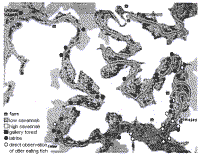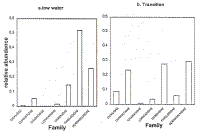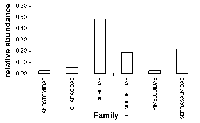 |
Last Update:
Thursday November 22, 2018
|
| [Home] |
|
Volume 16 Issue 2 Pages 58 - 110 (October 1999) Citation: Gómez, J. R. & Jorgenson, J.P (1999)An Overview of the Giant Otter-Fisherman Problem in the Orinoco Basin of Colombia IUCN Otter Spec. Group Bull. 16(2): 90 - 96 An Overview of the Giant Otter-Fisherman Problem in the Orinoco Basin of Colombia Juan Ricardo Gómez1 and Jeffrey P. Jorgenson2 1
OMACHA Foundation, Diag 145A # 31-04 Bogotá, COLOMBIA, jrgomez27@hotmail.com (received 30th August 1999, accepted 2nd December, 1999)
INTRODUCTION The giant otter faces a new threat in the Orinoco Basin because fishermen in that area see it as a competitor, alleging that the species diminishes the populations of fish that they (the fishermen) hope to capture. Due to these new conflicts between the otters and the inhabitants of the basin, it was deemed necessary to carry out a study that would clarify the supposed competition that exists between the otters and fishing activities. STUDY AREA AND METHODS The study area is located in the lower basin of the Bita River, in Easter Colombia, belonging entirely to the Department of Vichada. The altitude varies between 50 - 80 m.s.n.m. (IGAC, 1996). The annual mean temperature is 28°C and the average annual precipitation is approximately 2.200 mm. It belongs to the region known as the Llanos (IDEAM, 1998).
The soils of the area are poor and not suitable for pasture development and thus ranching is not common, instead, commercial fishing is one of the main economic activities in the area, providing the nutritional base for the inhabitants of the area. Most of the fish are consumed domestically, although some fishing co-operatives exist which standardise their fishing gear in line with the parameters allowed by the law. However, much fishing is now undertaken illegally, at prohibited times, and with illegal fishing methods ('chinchorros' [net with fine holes, like a mosquito net], wait nets, poisoning, and dynamite). These methods cause great harm to the fauna present in the region (pers. obs.). Sport fishing is a very limited source of revenue to some inhabitants of the area as there are commercial companies in the main cities of the country which organise such activities. The project had a duration of 15 months (Jul 1997-Oct 1998), but only 10 were dedicated to field work (Sep 1997-Jul 1998). The investigation was carried out over the periods of high water levels (May-Sep), transition (Mar-Apr, Oct-Nov), and low water levels (Dec-Feb) of the river Bita. Visits were made to markets, refrigerated storage rooms, and areas of fish discharge at the jetty of Puerto Carreño, where data was gathered on morphotype of fish, minimum and maximum sizes, fishing area, fishing method, and conflicts with groups of otters. A list of the species of fish of commercial importance was also elaborated, with legal minimum size of capture, to compare with the data found in the analysis of diet of the otter. The data for commercial fishes was taken during the dry and transition seasons (Nov-Apr), the periods of the year when this activity is allowed. Sport fishing data was taken in the dry season as the presence of sport fishermen is restricted to this period. Both sets of data included the number of fish captured, their size, and weight. The relative abundance of each species in catches was determined, and the similarity of the relative abundance of fishes taken was compared with the diet of the otter (determined in the larger study 'Feeding Ecology of the Giant Otter (Pteronura brasiliensis), in the Bita river, Vichada Colombia' (GÓMEZ, 1999). To assess similarity, the coefficient of similarity of communities of Sørensen and Morisita was used (FRANCO, 1995). RESULTS Character of the Diet The diet of giant otters consisted of fish (96.2% belonging to 4 different orders and 12 families), reptiles (2.2%, primarily turtles), birds (0.8%), and mammals (0.8%). The most frequently consumed fish were from the family Erythrinidae
(primarily Hoplias malabaricus), followed by Pimelodidae
(primarily Pseudoplatystoma fasciatum and Leiarius marmoratus),
Cichlidae (represented by the species Mesonauta festivum, Geophagus
sp. and Plagioscion surinamensis), and Characidae (with the
genera Brycon spp. and Acestrorynchus spp.). Potential Competition Between Otters and Fishermen Commercial fishing Commercial fishing in the area is allowed only in the dry and transition seasons, leaving a period of approximately 4 months during which potential competition doesn't occur directly. For commercial fishermen, the most frequently taken fish were members of the Serrasalmidae Family (28.6%), followed by Myrenidae (24.0%), Pimelodidae (19.0%), Curimatidae (18.3%), and Cichlidae (6.6%).
When the characteristic diet of the giant otter in this area is compared with that extracted by the commercial fishing enterprises it can seen that, although the otter is consuming fish that have some commercial importance (i.e. Curimatidae, Myrenidae, Serrasalmidae and Pimelodidae), the great majority of its diet is based upon families of no imporatance (i.e. Erythrinidae, Cichlidae, Anostomidae, Ctenolucidae, Osteoglossidae, and Cynodontidae). The level of similarity (FRANCO, 1995) between the fish in the diet of the giant otter and those taken by commercial fisheries differed to a large extent, principally in the composition of families (Im = 32.5% in total). Fishermen in the region, however, also claim that the otter is undesirable as it frightens fish from the key fishing areas. This problem was impossible to measure during the field phase and no previous work exists on this subject. It is also important to say that, according to informal interviews with fishermen, a decrease in the fishing resource in the area has been noted. However, this is almost certainly due to the increase in illegal and non-specific fishing activities in the area and not because the giant otter has increased its consumption rate of commercial fish. Sport fishing Reports of conflicts between sport fishermen and giant otters are not known. Sportsman apparently enjoy the presence of these animals, instead of seeing them as a nuisance or threat to their activity. However, Since commercial fishermen in the region are the same people who guide sport fishermen, some conflict has resulted. The sport fishing in the area is restricted to the dry season only, therefore any possible competition could only occur in an annual period no bigger than 4 months. The river Bita is very well known to sport fishermen for its excellent fishing of Pavón (Cichla sp.). The family Cichlidae, therefore, is the most affected by this activity (48%), followed by the Serrasalmidae (21%), and the Cynodontidae (18%). The data was calculated in the same way as that for commercial fishing. The comparison of similarity between sport's catches and the typical diet of the giant otter in the area produced a figure of 55% similarity, a result of more similarity to that of commercial fishing (Im = 35%), It should be kept in mind, however, that the species of the family Cichlidae pursed by the sport fishermen (Cichla ocellaris and Cichla temensis), are not the same as those consumed by the otter (Geophagus sp. and Mesonauta festivum). Sport fishermen also look for the biggest size in their prey and not the largest number (highest availability) of prey. Thus, representatives of the families Cichlidae (Cichla spp.), Serrasalmidae, and Cynodontidae, tend to be pursed by the sportsmen, leaving the other families of fish available for the giant otter.
CONCLUSION Although overlap exists in some of the families of fish that the otter consumes and those that the fishermen of the area extract, the competition for fish is minimal. The two samples differ as per the composition of families (Im=40% in total). Although the otter consumes some fish that have commercial importance (though in quantities that do not exceed 4 kg per day), the most representative fish in their diet lack commercial value. A further reason that fishermen consider the giant otter an undesirable animal is that, according to them, the otter frightens fish the key fishing zones. This problem was impossible to measure during the field phase and no previous work exists in this respect. It may be possible to counteract any conflict regarding this issue through educational workshops which persuade the fishermen to see the otter as a form of bioindicator, otters being distributed in those areas where fish numbers are likely to be most abundant. Although we cannot ignore that a problem exists between otters and some fishing activities, and the commercial fishermen in particular, this problem is not due to any impact that the otter has on the populations of fish. Rather, the problem can be attributed to the local inhabitants' lack of information toward the importance of the otter as a key species of the ecosystem. Further, there is a problem of interests, where the fishermen don't accept that they may themselves be the cause of the decrease of the resource, looking for other explanations to the phenomenon. For example, as the fishermen see that the otter takes out big fish, and makes a lot of noise when catching and consuming it, they believe that they frighten the fish away. Unlike the problems between otters and fish farms in Europe or Asia, the fishermen along the Bita River do not invest resources or effort in either fish cultivation or conservation of the fishing resource in the area. Instead they only harvest fish, apparently without any control. A change in the attitudes of fishermen is required, therefore, if the giant otter is not to become the victim of increasing conflict. REFERENCES Bisbal, F.J. (1988). Impacto humano sobre
los hábitat de Venezuela. Interciencia, Caracas, Venezuela. Resúmen: Un panorama general de la
problemática entre pescadores y nutrias gigantes en la cuenca del
Orinoco en Colombia |
| [Copyright © 2006 - 2050 IUCN/SSC OSG] | [Home] | [Contact Us] |



